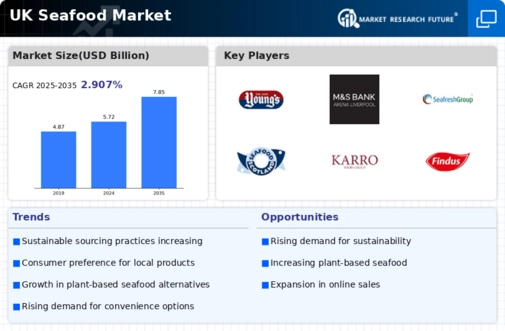Rising Demand for Sustainable Seafood
The seafood market in the UK is experiencing a notable shift towards sustainability, driven by increasing consumer awareness regarding environmental issues. This trend is reflected in the growing demand for sustainably sourced seafood, which has seen a rise of approximately 30% in recent years. Consumers are increasingly seeking certifications such as Marine Stewardship Council (MSC) to ensure their purchases align with ethical practices. Retailers are responding by expanding their offerings of sustainable products, which is likely to enhance their market share. The seafood market is thus adapting to these consumer preferences, indicating a potential long-term shift in sourcing and supply chain practices.
Impact of Health Trends on Seafood Consumption
Health trends are significantly influencing the seafood market in the UK, as consumers increasingly recognize the health benefits associated with seafood consumption. Rich in omega-3 fatty acids and essential nutrients, seafood is becoming a staple in health-conscious diets. Recent surveys indicate that 60% of consumers are actively seeking seafood options for their health benefits. This growing awareness is prompting retailers to promote seafood as a healthy alternative to red meat, thereby driving sales. The seafood market is likely to capitalize on this trend by enhancing product visibility and educational marketing efforts.
Evolving Consumer Preferences for Exotic Seafood
The seafood market in the UK is witnessing a shift in consumer preferences towards exotic and diverse seafood options. This trend is driven by a growing interest in culinary exploration and the desire for unique dining experiences. As a result, the market for exotic seafood varieties, such as octopus and sea urchin, is expanding. Recent data suggests that sales of these products have increased by 15% over the past year. The seafood market is responding by diversifying product offerings and enhancing marketing strategies to cater to this evolving consumer base, potentially leading to increased market penetration.
Technological Advancements in Seafood Processing
Technological innovations are playing a crucial role in the seafood market, particularly in processing and preservation methods. Advanced techniques such as vacuum packaging and modified atmosphere packaging are becoming more prevalent, extending the shelf life of seafood products. This is particularly relevant in the UK, where the seafood market is projected to grow by 5% annually due to improved processing technologies. These advancements not only enhance product quality but also reduce waste, which is a significant concern for both consumers and retailers. As a result, the industry is likely to see increased efficiency and profitability.
Regulatory Changes and Their Effects on the Seafood Industry
Regulatory changes are shaping the seafood market in the UK, particularly concerning fishing quotas and sustainability practices. The introduction of stricter regulations aims to protect marine ecosystems and ensure the long-term viability of fish stocks. These changes may pose challenges for some segments of the industry, but they also present opportunities for innovation and compliance. The seafood market is adapting by investing in sustainable practices and technologies to meet regulatory requirements. This proactive approach could enhance the industry's reputation and foster consumer trust, ultimately benefiting market growth.



















Leave a Comment